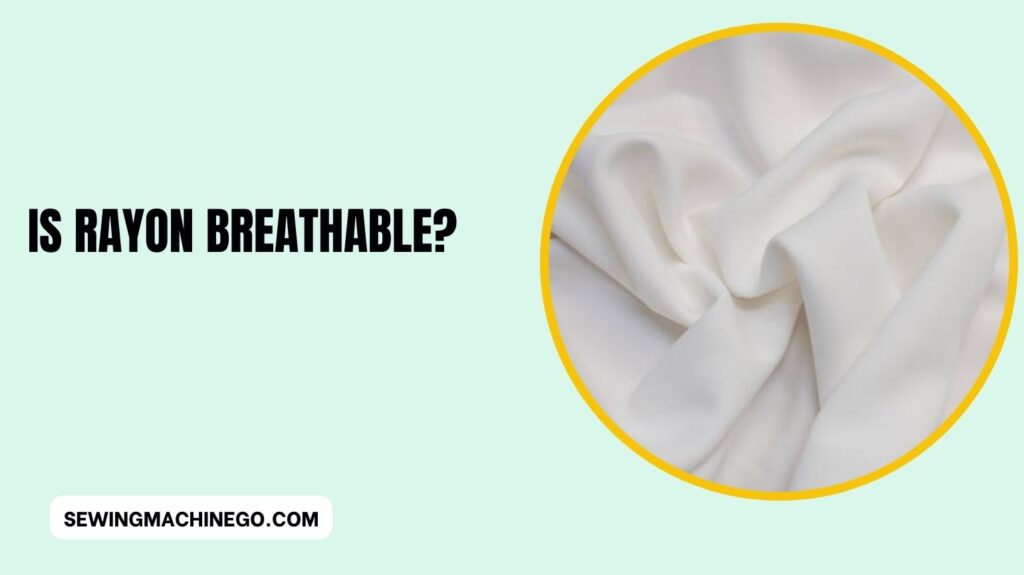Is Rayon Breathable? (Yes It’s Breathable) In 2024
Rayon, a versatile and widely used fabric, has long been a topic of discussion regarding its breathability. Is Rayon Breathable?
As a semi-synthetic fiber with properties resembling both natural and synthetic textiles, questions about its breathability often arise.
Understanding the intricacies of rayon’s composition, manufacturing process, and how it affects its breathability is crucial in discerning its suitability for various applications.
In exploring this subject, it becomes evident that the breathability of rayon involves a nuanced examination that considers multiple factors contributing to its overall comfort and wearability.

Is Rayon Breathable?
Rayon can be breathable due to its absorbent nature, but its breathability can vary based on the specific type of rayon, its weave, and other materials it’s blended with during manufacturing.
Generally, it tends to be more breathable than synthetic fibers but may not match the breathability of some natural fabrics like cotton or linen.
Introduction to Rayon Fabric
Rayon developed as an alternative to silk, is a semi-synthetic fabric derived from natural cellulose fibers, usually sourced from wood pulp.
It’s revered for its softness, draping qualities, and cost-effectiveness. However, its breathability has been a topic of debate among fabric enthusiasts.
Understanding Breathability in Fabrics
Breathability in textiles refers to the ability of a fabric to allow airflow and moisture vapor transmission. It determines how well a fabric can regulate temperature and keep the body comfortable.
Properties of Rayon
Rayon, known for its versatile nature, possesses breathable qualities. As a semi-synthetic fiber made from regenerated cellulose, it allows air to pass through easily, aiding in moisture absorption and ventilation.
This breathability makes it comfortable to wear in various climates, offering a cooling effect and reducing the likelihood of perspiration buildup.
Rayon’s porous structure contributes to its lightweight and airy feel, enhancing its suitability for clothing, especially in warm weather.
Moisture Absorption
Rayon boasts excellent moisture absorption capabilities, making it adept at wicking away perspiration from the skin. This feature contributes significantly to its perceived breathability.
Air Permeability
The air permeability of rayon varies based on its weave and construction. Some variations of rayon possess higher air permeability, facilitating improved breathability.
Factors Influencing Rayon’s Breathability
The breathability of rayon is influenced by multiple factors, including its fabric construction and blending with other materials. The way it’s woven or knitted can significantly impact its breathability.
Several factors influence the breathability of rayon fabric, determining how well it can allow air and moisture to pass through. Understanding these aspects is crucial in assessing rayon’s suitability in different conditions:
- Fabric Construction: The weaving or knitting pattern profoundly impacts rayon’s breathability. Loosely woven or knit fabrics tend to offer better air circulation compared to tightly woven ones.
- Type of Rayon: Different types of rayon, such as viscose, modal, or lyocell, exhibit varying breathability. Modal, known for its softness and moisture-wicking properties, is often considered more breathable than viscose.
- Blending with Other Materials: Rayon is often blended with other fibers like cotton, polyester, or spandex to enhance its properties. The ratio and type of blending can affect its breathability. For instance, a higher percentage of synthetic fibers in a blend might reduce breathability.
- Finishing Treatments: Certain finishing processes applied to rayon fabrics, such as coatings or treatments for wrinkle resistance, can affect its breathability. Some finishes might create barriers that hinder airflow.
- Weight and Thickness: Thicker or heavier variants of rayon may inhibit breathability due to a denser fabric structure, while lighter-weight versions typically allow for better air permeability.
- Environmental Conditions: Rayon’s breathability can also be influenced by the external environment. In humid conditions, rayon’s moisture-absorbing properties might impact its perceived breathability positively, keeping the wearer comfortable.
Considering these factors can help in understanding and optimizing rayon’s breathability for various clothing applications and environmental settings.
Advantages of Rayon in Terms of Breathability
Rayon’s ability to wick moisture away from the body makes it a favorable choice for hot and humid climates. Its lightweight nature aids in maintaining a cool and comfortable feel.
Rayon boasts several advantages in terms of breathability, making it a favorable choice for clothing in various conditions:
- Moisture Absorption: Rayon’s natural cellulose composition enables it to absorb moisture efficiently. It wicks away sweat from the body, keeping the skin dry and comfortable. This feature makes it particularly suitable for warm or humid climates.
- Air Permeability: Depending on the fabric construction and type of rayon, it can exhibit good air permeability. Loosely woven or knit rayon fabrics allow air to circulate, aiding in ventilation and enhancing breathability.
- Cool and Lightweight: Rayon is lightweight and has a smooth texture, offering a cool and airy feel against the skin. This characteristic contributes to its comfort in hot weather, allowing for better airflow and reducing heat retention.
- Versatility in Garments: Rayon’s breathability makes it versatile for various clothing items. It’s commonly used in summer dresses, blouses, shirts, and linings due to its ability to keep the body cool and dry.
- Adaptability to Layering: Rayon’s breathability makes it suitable for layering in different seasons. It can serve as a base layer in winter for moisture-wicking properties while maintaining comfort in summer as an outer layer.
- Comfortable Draping: Rayon’s soft and flowing nature contributes to its breathability. Its drapey quality allows air to move freely around the body, enhancing overall comfort.
- Ease of Care: Rayon garments are often easy to care for, and proper maintenance, such as gentle washing and avoiding high heat while drying, can maintain their breathability over time.
Understanding these advantages can help individuals make informed choices about incorporating rayon garments into their wardrobes for breathable and comfortable clothing options.
Limitations or Drawbacks of Rayon’s Breathability
However, certain types of rayon, especially tightly woven variants, might restrict airflow, affecting its overall breathability. Additionally, blended rayon fabrics might alter its moisture-wicking properties.
While rayon offers various benefits in terms of breathability, it also presents some limitations or drawbacks:
- Weave Density Impact: Tightly woven rayon fabrics might restrict airflow, reducing their overall breathability. Fabrics with a higher thread count or denser weaves may limit air circulation, affecting comfort in warm conditions.
- Blending with Other Materials: When blended with synthetic fibers like polyester or nylon, the breathability of rayon can be compromised. Higher percentages of non-breathable materials in the blend can reduce rayon’s ability to wick moisture and allow airflow.
- Moisture Retention: In certain circumstances, rayon fabrics can retain moisture, especially in high humidity or when exposed to excessive sweat. This retention might lead to a damp feeling, detracting from its perceived breathability.
- Wrinkle Susceptibility: Some types of rayon, especially when not blended with wrinkle-resistant materials, can wrinkle easily. This might hinder airflow, particularly in creased areas, affecting breathability.
- Durability Concerns: While rayon is comfortable and breathable, it might be less durable compared to some natural fibers like cotton or linen. Excessive wear or washing can impact its breathability over time, reducing its effectiveness.
- Care Sensitivity: Improper care, such as using high heat during laundering or harsh chemicals, can affect rayon’s structure and impact its breathability. Following specific care instructions is crucial to maintain its properties.
How to Enhance Rayon’s Breathability?
To enhance the breathability of rayon clothing, proper care, and layering strategies can be employed. Gentle washing and avoiding high heat while drying can help maintain its breathability.
Comparison with Other Breathable Fabrics
When compared to natural fibers like cotton and linen, rayon showcases competitive breathability. However, it might not match the breathability of certain synthetic performance fabrics designed explicitly for moisture management.
Real-Life Applications and Use Cases
Rayon’s versatility extends to various clothing items like summer dresses, blouses, and athletic wear due to its comfortable feel in warm weather.
Misconceptions About Rayon’s Breathability
Despite misconceptions, rayon, when appropriately manufactured and cared for, can offer commendable breathability, making it a viable choice for many climates.
People also ask
Is rayon more breathable than cotton?
Rayon’s breathability varies based on its weave and type, often offering competitive breathability to cotton.
However, certain rayon variants, especially loosely woven types, can be more breathable than some cotton fabrics, as they efficiently wick moisture and allow air circulation, ensuring comfort in various conditions.
Is rayon good for hot weather?
Rayon can be a good choice for hot weather due to its moisture-wicking properties and lightweight nature, providing a cool and comfortable feel by efficiently absorbing moisture from the skin and allowing airflow, making it suitable for warm climates.
Will rayon make me sweat?
Rayon’s moisture-absorbing properties can help manage sweat by wicking it away from the skin, promoting evaporation and maintaining comfort.
However, in humid conditions or with tightly woven variants, it might retain some moisture, potentially causing a damp feeling.
What is the coolest most breathable fabric?
Fabrics like linen, certain types of cotton, and modal are among the coolest and most breathable.
Their natural properties and weave allow excellent airflow, moisture-wicking, and heat dissipation, ensuring optimal comfort in warm conditions.
Conclusion
In conclusion, the breathability of rayon is influenced by its unique blend of natural and synthetic characteristics.
While it can offer decent breathability due to its absorbent nature, variations in its manufacturing and blending with other fibers can affect this quality.
Understanding these factors is essential in determining the breathability of rayon, making it a versatile yet nuanced choice in the world of fabrics.

Hi, I am Alice, and I am your perfect guide to the world of sewing machines. With over 10 years of experience in the sewing industry, I am passionate about sharing my knowledge and expertise to help you make the most of your sewing journey. about me






